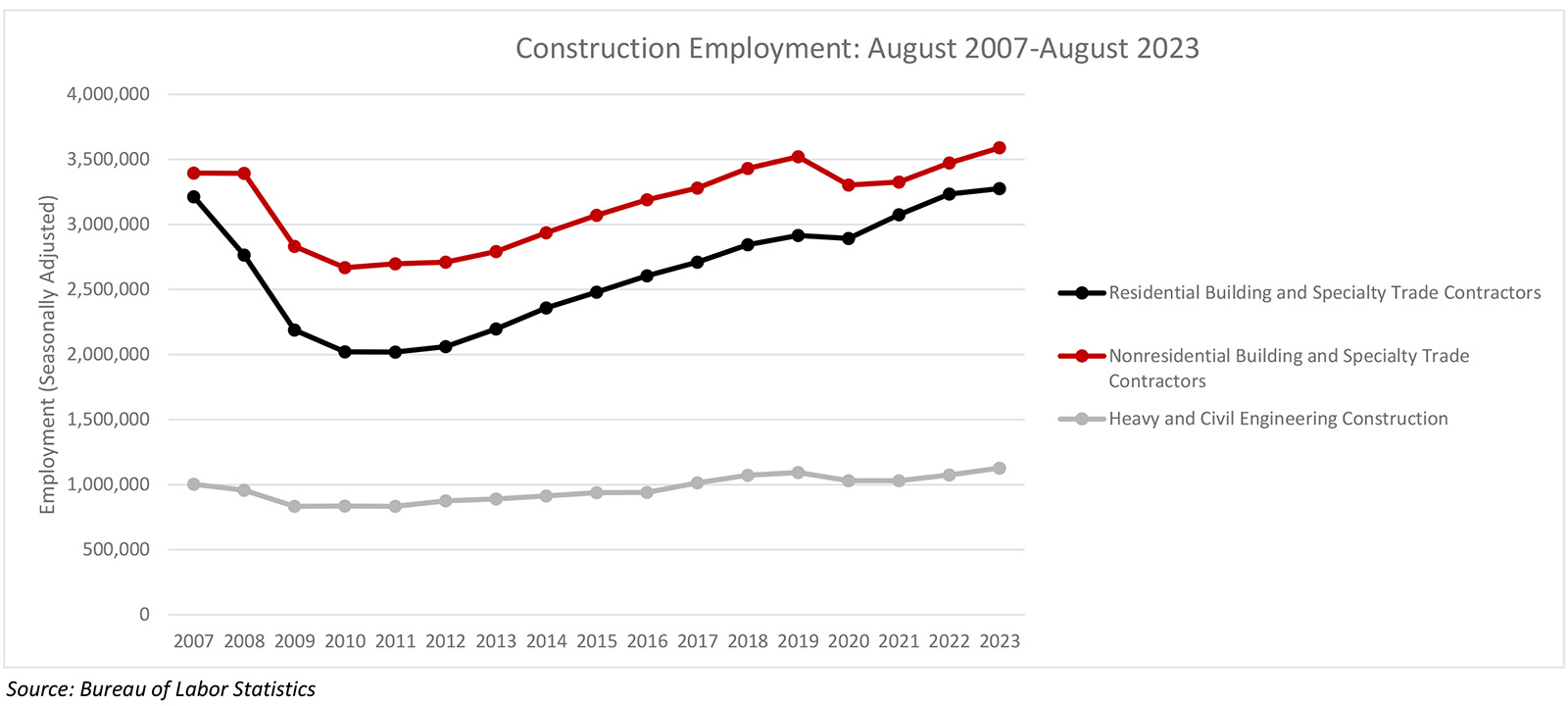
According to data released Friday by the US Bureau of Labor Statistics, the national construction industry gained 22,000 jobs on net in August.
Key Takeaways
- The construction industry gained 22,000 jobs on net in August. Year-over-year, industry employment has risen by 212,000 jobs, or 2.7%.
- Nonresidential construction employment increased by 21,000 positions on net, with gains in all three subcategories.
- "Today’s reports show there is no letup in demand for construction workers or private-sector projects. The industry is raising pay faster than other sectors amid persistently low unemployment. But contractors are frustrated by the slow pace of new public project awards."

Press Release from Associated Builders and Contractors, Inc (ABC)
ABC: Nonresidential Construction Dominates Industry Job Creation in August
WASHINGTON, Sept. 1—The construction industry added 22,000 jobs on net in August, according to an Associated Builders and Contractors analysis of data released today by the U.S. Bureau of Labor Statistics. On a year-over-year basis, industry employment has increased by 212,000 jobs, or 2.7%.
The lion’s share of job creation was among nonresidential contractors. Nonresidential construction employment increased by 21,000 positions on net, with growth registered in all three major subcategories. Nonresidential specialty trade added 12,100 positions, while heavy and civil engineering and nonresidential building added 7,100 and 1,800 jobs, respectively.
The construction unemployment rate remained unchanged at 3.9% in August. Unemployment across all industries expanded from 3.5% in July to 3.8% last month.
"This is the era of the megaproject," said ABC Chief Economist Anirban Basu. "While many private developers are encountering harsher lending markets and suffering greater difficulty financing projects, the transformation of American manufacturing, combined with accelerating infrastructure spending, has dramatically increased demand for construction workers. Many of these projects exceed $1 billion. This is especially true in certain parts of the nation, including Ohio, Texas and Arizona."
"Given the outsized role of megaprojects in the current economic environment, it is conceivable that the construction industry will face recessionary conditions in certain areas of the country sometime during the next two years, even as activity surges in others,” said Basu. “This suggests that many construction workers may decide to relocate as the disparity in industry performance widens both geographically and among various industry segments."
Press Release from Associated General Contractors of America (AGC)
Construction Employment Reaches 7,993,000 amid Strong Demand for Project, Firms Boost Pay to $34.40 an Hour as They Try to Attract a Limited Pool of Qualified Workers with Sector’s Unemployment at 3.9%
The construction industry added 22,000 jobs in August, while total construction spending rose 0.7 percent in July, despite a downturn in most infrastructure investment categories, according to an analysis of new government data the Associated General Contractors of America released today. Association officials cautioned that progress on many public infrastructure projects was likely being undermined by the added layers of red tape the Biden administration continues to add for new public works efforts.
"Today’s reports show there is no letup in demand for construction workers or private-sector projects,” said Ken Simonson, the association’s chief economist. "The industry is raising pay faster than other sectors amid persistently low unemployment. But contractors are frustrated by the slow pace of new public project awards."
Construction employment in August totaled 7,993,000, seasonally adjusted, an increase of 22,000 from July and 212,000 or 2.7 percent from a year earlier. That outpaced total nonfarm job growth of 2.0 percent over 12 months. Nonresidential construction firms—nonresidential building and specialty trade contractors along with heavy and civil engineering construction firms—added 21,000 employees for the month and 169,700 (3.7 percent) since July 2022. Employment at residential building and specialty trade contractors grew by 1,400 last month and 42,400 (1.3 percent) over 12 months.
Average hourly earnings for production and nonsupervisory employees in construction—covering most onsite craft workers as well as many office workers—jumped by 5.7 percent over the year to $34.40 per hour in August. Construction firms paid a wage “premium” of 18.6 percent compared to the average hourly earnings for all private-sector production employees. However, contractors report difficulty finding qualified workers amid an unemployment rate of only 3.9 percent in August for jobseekers with construction experience.
Construction spending in July totaled $1.97 trillion at a seasonally adjusted annual rate, an increase of 0.7 percent from June and 5.5 percent from July 2022. Private residential spending climbed 1.4 percent for the month, while private nonresidential spending rose 0.5 percent. But public construction spending slid 0.4 percent as the largest infrastructure categories declined from June. Highway and street construction spending fell by 0.6 percent, transportation by 0.9 percent, and sewage and waste disposal by 1.2 percent.
Association officials noted that public construction activity has been hampered by a flurry of regulatory measures that are causing confusion and slowing approvals on projects. They noted that this week alone the administration issued new rules that will add to the confusion around what constitutes a water of the U.S. and others that seek to apply federal wage rates to projects funded by the so-called Inflation Reduction Act.
"It appears that the Biden administration can’t decide if it wants projects to get built or prefers to suffocate them with red tape," said Stephen E. Sandherr, the association’s chief executive officer. "At some point, people are going to begin wondering what happened to all those projects the administration promised would be built."













